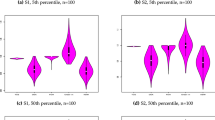Abstract
The main objective of the paper is to assess the performance of urban local governments in India taking the physical levels of services provided by them as the ‘outputs’ and the expenditures on resources to provide these services as ‘inputs’ in an integrated framework and pinpoint some possible sources of mis-utilization of resources. We use nonparametric two-stage data envelopment analysis technique to derive the efficiency scores, with a subsequent analysis of slacks associated with the optimization exercise which quantifies the extent of mis-utilization of resources. The main findings suggest that the city governments can provide the same levels of services by using resources lesser by 27 % of what they currently use. We also find that the extent of unproductive spending and under-provision of services are more pronounced in smaller cities. Mis-utilization of resources in factors like establishment and laborcost is more pronounced as the establishment expenditures and contractual payments in the laborcost component involve more leakages.



Similar content being viewed by others
Notes
Actually the study comprises of 215 urban local governments but data for two ULBs were not sufficient to apply the methodology.
Census towns and notified areas are small but separate ‘geographical entities’ in urban areas, but they are not separate units of ‘urban local governments’ who perform certain functions for the citizens. As a result of this, they do not have budgets or statements to expenditures. Similarly, there are certain geographical areas—mostly having military establishments—called cantonment areas governed by a board–which function in a very different way than a town or a city. These boards are centrally administered by Ministry of Defense. There is only one cantonment board in the state of Karnataka. Keeping in mind these considerations, we can rationalize the omission of these units.
It is to be noted that the analysis is subject to some data constraints. We cannot verify the street lighting physical norms as the data on distance between two poles for the ULBs are not available. For financial norms, we only confine ourselves to O&M norms as the capital expenditure data as annual expenditures are not recorded as they are lumpy in nature and are incurred generally on specific project-related outlays.
The case for street lighting is different as we find that the expenditures incurred are 1051 % more than that prescribed by norms. This can be attributed to the fact that the state is changing over to the low-energy-intensive bulbs for street lighting. As the ONM includes the cost of bulbs, we get such unusually high figures for expenditures in this transition period as the low-energy bulbs cost on an average 20 times more than the usual ones and the norms do not include additional costs of changing over from high-energy-consuming bulbs to low-energy-consuming bulbs.
Estimating expenditure functions and expenditure needs has many data-related and methodological problems. So we have to rely on expert judgment approach which has been used for many US and Australian cities for specific services (Reschovsky 2007).
It is to be noted that the input slack in percentages cannot exceed 100 as the optimization exercise in production involves minimization of inputs and the potential reduction in inputs cannot exceed the amounts of inputs used in the model, whereas output slacks can exceed 100 as output expansions are determined from the model and the potential expansion can exceed the amount of outputs produced.
References
Bandyopadhyay S (2011) Finances of urban local bodies in Jharkhand: some issues and comparisons. International Studies Program working paper 11-13. Andrew Young School of Policy Studies, Georgia State University, Atlanta, May 2011
Bandyopadhyay S (2012) Performance evaluation of urban local governments: a case for Indian cities. International Center for Public Policy working paper 12-32. Andrew Young School of Policy Studies, Georgia State University, Atlanta, Oct 2012
Bandyopadhyay S, Rao MG (2009) Fiscal Health of Selected Indian Cities’, Policy Research working paper no. 4863. The World Bank, World Bank Institute, Poverty Reduction and Economic Management Division, Washington DC, March 2009
Bandyopadhyay S, Bohra OP (2010) Functions and finances of urban local bodies in Jharkhand. Draft report submitted to Government of Jharkhand, National Institute of Public Finance and Policy, New Delhi
Banker R, Charnes A, Cooper WW (1984) Some models for estimating technical and scale inefficiencies in data envelopment analysis. Manag Sci 30:1078–1092
Census of India (2011)
Charnes A, Cooper WW, Rhodes E (1978) Measuring the efficiency of decision making units. Eur J Oper Res 2:429–444
De Borger B, Kerstens K, Moesen W, Vanneste J (1994) Explaining differences in productive efficiency: an application to Belgian municipalities. Public Choice 80:339–358
Debreu G (1951) The coefficient of resource utilization. Econometrica 19(3):273–292
Eeckaut VP, Tulkens H, Jamar MA (1993) Cost efficiency in Belgian municipalities. In: Fried HO, Lovell CAK, Schmidt SS (eds) The measurement of productive efficiency. Oxford University Press, Oxford, pp 300–334 (Chapter 12)
Farrell MJ (1957) The measurement of productive efficiency. J R Stat Soc Ser A (Gen) 120(3):253–290
Farrell MJ, Fieldhouse M (1962) Estimating efficient production frontiers under IRS. J R Stat Soc Ser A 125(2):252–267
GOI (2008) Eleventh five year plan (2007–12). Oxford University Press, New Delhi
GOI (2012) Twelfth five year plan (2012–17). Sage, New Delhi
Grossman PJ, Mavros P, Wassmer RW (1999) Public sector technical inefficiency in large U.S. cities. J Urban Econ 46:278–299
Hoffman AJ (1957) Discussion on Mr. Farrell’s paper. J R Stat Soc Ser A 120(3):284
HPEC (2011) Report on Indian infrastructure and services, March 2011
Koopmans TC (1951) An analysis of production as an efficient combination of activities. In: Koopmans TC (ed) Activity analysis of production and allocation. Wiley, London
Mohanty PK, Mishra BM, Goyal R, Jeromi PD (2007) Municipal finance In India—an assessment. Study no. 26. Development Research Group, Department of Economic Analysis and Policy, Reserve Bank of India, Mumbai
NIPFP (2009) Urban property tax potential in India. Submitted to Thirteenth Finance Commission, India
Ramanathan R, Dasgupta S (2009) Estimates of urban infrastructure financing in India 2006–2031. Draft paper for High Powered Expert Committee on Urban Infrastructure, Aug 2009
Rao MG, Bird R (2010) Urban governance and finance. NIPFP working paper 68
Rao MG, Bird R (2011) Coping with change: the need to restructure urban governance and finance in India. IMFG papers on municipal finance and governance, no. 4
Reschovsky A (2007) Compensating local governments for differences in expenditure needs in a horizontal fiscal equalization program. In: Boadway R, Shah A (eds) The theory and practice of intergovernmental fiscal transfers. The World Bank, Washington, pp 397–424
Zakaria Committee Report (1963) Augmentation of financial resources of urban local bodies. Report of the Committee of Ministers, Constituted by the Central Council of Local Self Government
Author information
Authors and Affiliations
Corresponding author
Appendix
Rights and permissions
About this article
Cite this article
Bandyopadhyay, S. Financial management and service delivery: a nonparametric analysis for Indian cities. Ann Reg Sci 54, 721–751 (2015). https://doi.org/10.1007/s00168-015-0673-1
Received:
Accepted:
Published:
Issue Date:
DOI: https://doi.org/10.1007/s00168-015-0673-1




